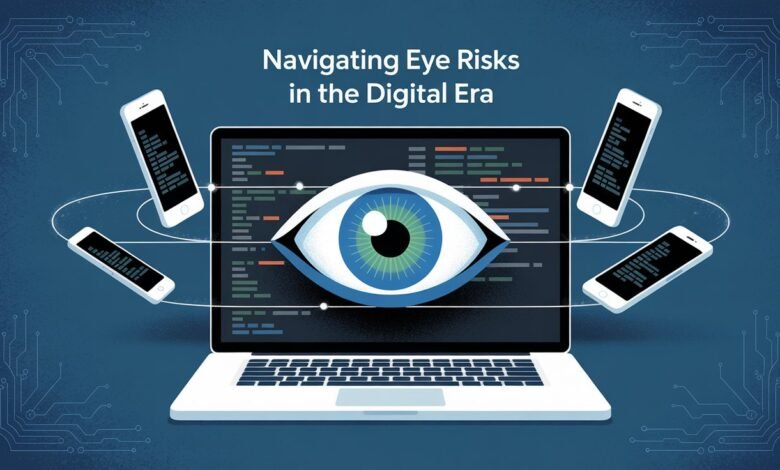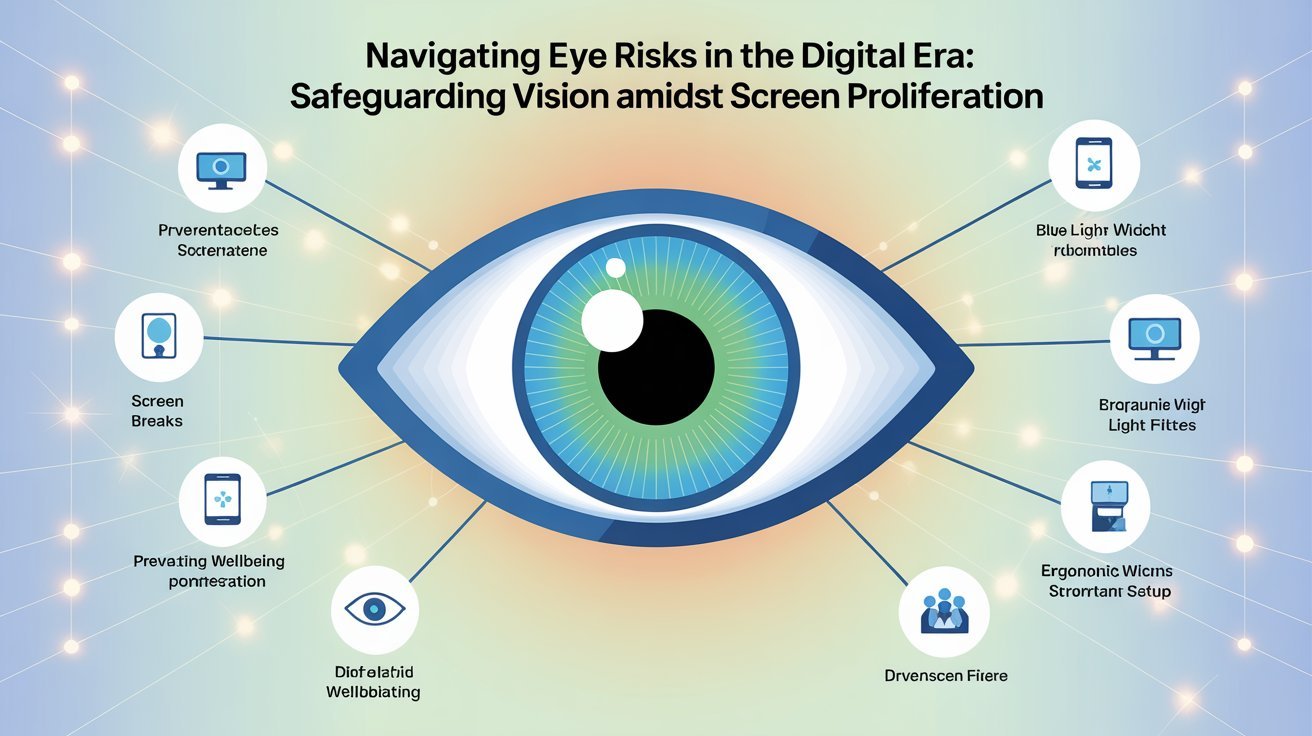
Introduction
In an age dominated by screens, our eyes are subjected to unprecedented strain. From smartphones to laptops, digital devices have become integral to daily life, yet their prolonged use poses significant risks to ocular health. Terms like “digital eye strain,” “blue light exposure,” and “screen fatigue” are now commonplace, reflecting growing concerns about the long-term impact of screen time. This article delves into the complexities of eye risks in the digital era, exploring contributing factors, consequences, and actionable strategies to protect vision. By understanding these challenges, individuals can adopt practices to mitigate harm and preserve eye health in a screen-saturated world.
1. The Escalating Prevalence of Digital Eye Strain
Digital Eye Strain (DES), also known as Computer Vision Syndrome, affects millions globally. Symptoms include dryness, blurred vision, headaches, and neck pain, often exacerbated by prolonged screen use. Studies suggest that over 50% of screen users experience DES, with remote work and online learning amplifying exposure. The human eye isn’t evolutionarily adapted to focus on pixels for extended periods, leading to muscle fatigue. Unlike printed text, screens emit light directly, forcing eyes to work harder. This strain is compounded by infrequent blinking—a reflex that moistens the eyes—which drops by 66% during screen use, according to ophthalmological research. Addressing DES requires recognizing its ubiquity and adopting preemptive measures.
2. Blue Light Exposure: A Double-Edged Sword of Modern Technology
Blue light, a high-energy visible (HEV) wavelength emitted by screens, is a major contributor to eye risk. While natural blue light from the sun regulates circadian rhythms, artificial sources—like LEDs and OLEDs—can disrupt sleep patterns and cause retinal stress. Research indicates that prolonged exposure may accelerate macular degeneration, a leading cause of vision loss. Though the cornea and lens filter some blue light, cumulative exposure from devices can overwhelm these defenses. Critics argue that the risks are overstated, but optometists emphasize moderation. Tools like blue light filters and “night mode” settings on devices offer partial mitigation, though their efficacy varies. Balancing screen use with protective measures is key to minimizing harm.
3. Ergonomic Practices: Aligning Screen Habits with Physical Well-Being
Poor ergonomics exacerbate eye strain and musculoskeletal issues. Screens positioned too high or low force unnatural neck angles, while glare from overhead lighting causes squinting. The 20-20-20 rule—looking 20 feet away for 20 seconds every 20 minutes—reduces focus fatigue. Additionally, maintaining an arm’s length distance from screens and ensuring screens are at eye level can alleviate strain. Anti-glare screen protectors and adjustable monitor stands are practical investments. Ergonomic adjustments not only protect vision but also enhance productivity, creating a symbiotic relationship between comfort and efficiency.
4. Long-Term Consequences of Unmitigated Eye Risks
Ignoring eye strain can lead to chronic conditions. Persistent dryness may evolve into keratoconjunctivitis sicca (chronic dry eye), while uncorrected refractive errors can worsen. Children, whose eyes are still developing, face higher risks; excessive screen time correlates with myopia progression. The World Health Organization predicts that by 2050, half the global population could be myopic, partly due to digital device usage. Furthermore, sleep disruption from blue light exposure links to broader health issues like obesity and cardiovascular disease. Proactive eye care is thus essential to prevent irreversible damage.
5. Technological Innovations: Allies in Eye Health Protection
Paradoxically, technology also offers solutions. Apps like f.lux adjust screen color temperatures based on time of day, while smart glasses with blue light filtering coatings gain popularity. E-ink displays, used in e-readers, mimic paper and reduce glare. Advances in AI monitor user behavior, prompting breaks via notifications. Telemedicine platforms enable remote consultations with optometrists, democratizing access to care. While technology isn’t a panacea, its thoughtful integration can offset the very risks it creates.
6. Holistic Strategies for Sustainable Eye Health
Protecting vision requires a multifaceted approach. Regular eye exams detect issues early, while dietary choices rich in lutein (e.g., leafy greens) support retinal health. Hydration and humidifiers combat dryness in air-conditioned environments. Employers can foster eye-friendly workplaces through flexible screen-time policies and ergonomic assessments. Public awareness campaigns, particularly targeting youth, can instill healthy habits early. Vision preservation is not merely an individual responsibility but a collective endeavor.

Conclusion
As digital devices entrench themselves deeper into daily life, understanding and addressing eye risks becomes imperative. From adopting ergonomic practices to leveraging technology wisely, small changes can yield significant benefits. By prioritizing eye health today, individuals can safeguard their vision for tomorrow, ensuring that screens remain tools of empowerment rather than sources of harm.
Frequently Asked Questions (FAQs)
Q1: What are the early signs of digital eye strain?
Early symptoms include dryness, redness, blurred vision, and headaches. Neck or shoulder pain may also occur due to poor posture. Taking regular breaks and adjusting screen settings can alleviate these issues.
Q2: Do blue light glasses really work?
Studies show mixed results. While they reduce glare and filter some blue light, their impact on sleep and eye strain varies. They’re most effective when combined with other practices, like limiting screen time before bed.
Q3: How much screen time is safe for children?
The American Academy of Pediatrics recommends no more than 1 hour per day for children aged 2–5, and consistent limits for older kids. Encourage outdoor activities to counteract myopia risks.
Q4: Can eye exercises improve vision?
While exercises can reduce fatigue, they don’t cure refractive errors. Techniques like focusing on distant objects help relax eye muscles but shouldn’t replace corrective lenses if needed.
Q5: Are OLED screens better for the eyes than LCDs?
OLEDs emit less blue light than LCDs, but both can cause strain. Using dark mode and lowering brightness are more impactful than screen type alone.
By addressing these concerns, individuals can navigate the digital landscape with greater confidence and clarity.


